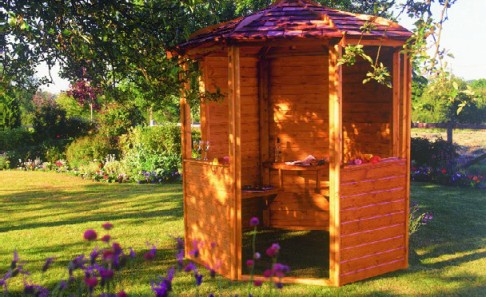In the Garden
Wood Campus Timber Trade Topics are produced in collaboration with Timber Development UK and the industry technical expert on the subject, in this case, the Timber Decking and Cladding Association and the Wood Preservative Association. For further information, visit www.tdca.org.uk or www.thewpa.org.uk
TOPIC CHECKLIST
- Check whether the project needs planning permission.
- Is the timber treated to the right Use Class?
- Have I treated any cut ends?
- Will any play equipment be safe?
- Are the fence posts the right size?
Do I need planning permission?
It’s worth checking with your local authority planning department, especially if you live in a listed building, conservation area, Area of Outstanding Natural Beauty, or National Park.
Outbuildings don’t generally need planning permission, so long as:
- They are not built on land forward of a wall forming the house’s main elevation
- They are single-storey, with a maximum eaves height of 2.5 metres, and maximum overall height of four metres with a dual pitched roof; or three metres for any other roof
- They have a maximum height of 2.5 metres if within two metres of a boundary of the house
- No more than half the area of land around the original house will be covered by additions or other buildings
Rules governing outbuildings apply to sheds, greenhouses and garages as well as other ancillary garden buildings such as swimming pools, ponds, sauna cabins, kennels and enclosures (including tennis courts).
Verandahs, balconies and other platforms (including tree houses/playhouses) require planning permission, with the exception of decking up to 300mm above ground level.
The performance of naturally durable hardwoods can be matched by low-cost preservative-treated softwoods.
But not all preservative-treated timber is suitable for use in the garden.
Make sure you ask for timber treated to Use Class 4 for any structural members or timber that will end in contact with the ground.
Use external grades fixings, usually hot-dipped galvanized or stainless steel. Further advice on fixings is available in this Timber Trade Topics series.
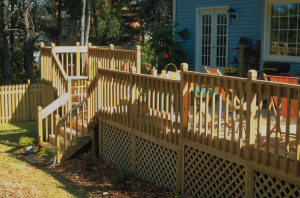
The right timber for the job
Use timber capable of giving a service life of at least 15 years. This means either a naturally durable species, such as ipe, iroko, oak, jarrah, balau and Western red cedar, or a softwood that has been pressure-treated to the right level for the job.
Most timber sold for use in the garden has already been pressure-impregnated with wood preservative and may be recognized by its green or mid-brown tint. Check with your supplier whether the timber is suitable for above ground or in-ground contact (see the treated wood Use Class table below):
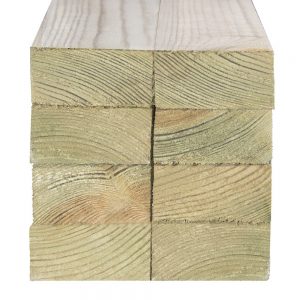
| USE CLASS | APPLICATION | RISK OF FAILURE | SUITABLE FOR DECKING |
|---|---|---|---|
| 3u (uncoated) | External: out of the ground non structural | Medium/High | Yes – for deck boards and non-structural timbers above ground |
| 4 | In ground contact or fresh water External: structural and/or in permanent ground or water contact | High | Yes – for structural members as well as posts in ground contact |
Modern preservatives are safe
Modern pressure-impregnated wood preservatives and water-based proprietary products are safe for plants, pets and people unless eaten.
If you are using solvent-based preservatives or coatings on sheds or fence panels, follow the manufacturer’s advice and instructions.
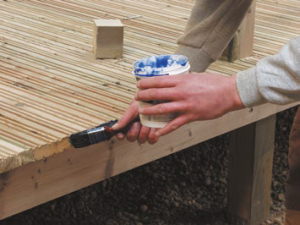 Fencing and posts
Fencing and posts
Check fence panels are suitably pre-treated, so they won’t need further treatment, unless you want to paint or stain them.
Use gravel boards (pressure-treated to Use Class 4) to support the panels off the ground so as to extend their service life. It’s cheaper and easier to replace any failed boards than the panels themselves.
Gravel boards will take up any unevenness in ground levels, so the fence panels can simply be slotted into place.
Use Class 4 pre-treated fence posts are available in a range of lengths and sizes. Use a minimum section of 75mm x 75mm – larger for exposed areas or particularly high fences. Incised pre-treated Use Class 4 posts are available with a 15-year warranty.
Make sure your fence posts are the right length, based on the height of the panel:
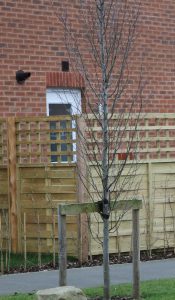
| Panel height | Minimum embedded into ground | Minimum post length (no gravel board) | Minimum post length (150mm gravel board) |
|---|---|---|---|
| 1,400 or less | 500mm | Panel height + 500mm | Panel height + 650mm |
| 1,400 – 2,000 | 600mm | Panel height + 600mm | Panel height + 750mm |
Cutting or notching will expose untreated timber, which should be treated with a generous coat or two of brush-applied end-grain sealer or preservative.
Play equipment
Consider the suitability of the location, the safety of the ground surface and whether the equipment requires securing (e.g. in concrete). Check the equipment is CE marked and that the packaging states it is manufactured to meet BS EN 71.
Follow the manufacturer’s installation instructions carefully. Avoid sharp edges, rough surfaces and protruding fixings, adding caps to all ends. Use suitable, water-based coatings.
Ideally you should seek specialist advice before designing or building garden play equipment, as you must observe the relevant safety standards. For example, you will need to avoid small gaps that could trap children’s fingers or heads.
Isolate pre-treated timbers from ponds using a liner.
Timber garden buildings
There are many different types of timber garden buildings, including sheds, kennels, decks and tree houses. Many are sold in panels that can simply be nailed together. Others, such as summer houses or log cabins, may need screws or coach bolts to fix them together. They will usually be pressure-treated. To ensure a long life:
- Support floors off the ground on appropriately treated pressure-impregnated timber bearers (which may be supplied with the building) on a concrete or paving-slab base
- Avoid damage to roofing felts, and fix roof coverings, such as shingles or slates, correctly, as any leaks could result in premature failure.
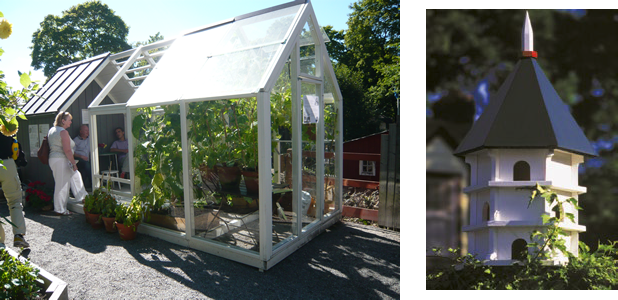
Sleepers
These are popular for making raised beds, steps or pond structures. Use new sleepers, as they are treated with modern preservatives. Creosote-treated timbers (typically old railway sleepers) are best avoided as there are restrictions on creosote use in gardens in areas likely to be in frequent skin contact.
For guidance on the use or disposal of used creosote-treated timber, contact the Wood Protection Association (see Further information and advice).
Don’t burn offcuts from pre-treated timber on a bonfire or barbecue. They should be disposed of in a landfill site, or incinerated in accordance with national regulations.
Further information and advice
Other relevant Timber Trade Topics:
- Decking
- Fixings
Relevant associations:
The Timber Decking and Cladding Association
Wood Protection Association
Planning permission:
www.planningportal.co.uk
British Standards
BS 1722-11: 2006 Fences. Specification for prefabricated wood panel fences, BSI
BS EN 71-1: 2011 Safety of toys. Mechanical and physical properties, BSI
Sustainable timber
Timber is the most sustainable mainstream building product. It is naturally renewable. Over 90% of timber used in UK construction comes from Europe, where more trees are grown than harvested (source: TTF Statistical Review 2016).
Softwood and temperate hardwood forests in Scandinavia, Europe, Canada and North America are stable or growing. Growing forests act as carbon sinks; wood products act as carbon stores.
Ask for PEFC or FSC Chain of Custody certification.
See Wood Campus RIBA CPD module Procuring Sustainable Timber for more on timber certification and sustainability and government requirements.


